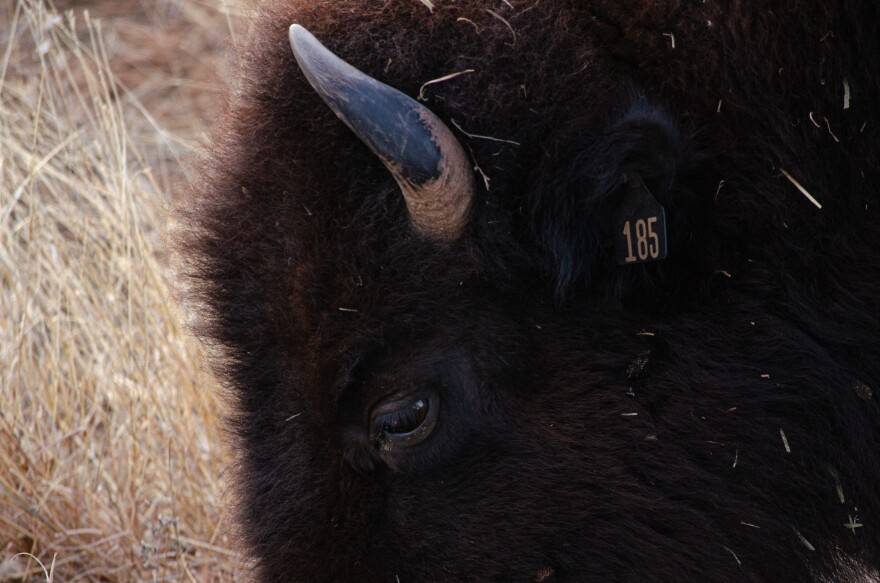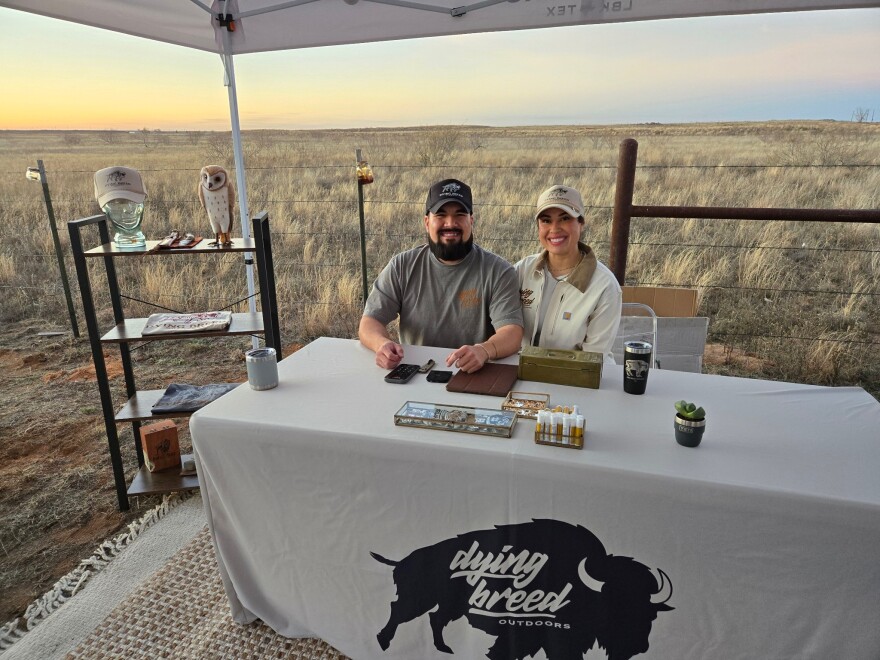The paths to the First Friday Art Trail were filled with people walking in synchronized steps, avoiding traffic as we approached the tent stationed by Two Docs Brewing Co.
A grey Toyota Tacoma with a matching camper shell had its bed laid out, filled with plastic containers of what we would soon discover. We were greeted with an enthusiastic hello from Gabe Carrasco, the founder of Dying Breed Outdoors, as we ducked under the canopy.
Carrasco guided us through his setup, showing off the t-shirts he designed. Each shirt was detailed with an American bison and its skeleton shining through, the name “Dying Breed” referencing the history of the species in the southern portion of the great plains. His booth was decorated with books telling the history of the animal, which he quickly offered to let me borrow.
“Do you know the history of the Goodnights?” he asked after handing me the green cloth-bound pages.
The four years between 1874 and 1878 were referred to as the Great Slaughter, a time of defeat for the powerful animal of the Great Plains. After professional hunters arrived, the number of bison started to decline due to the weapons that equipped them, allowing them to take as many as 100 bison at a time, according to the Texas Parks and Wildlife website.
“Mary Ann Goodnight; I don’t think she gets enough credit,” he said.

The wife of Charles Goodnight, a rancher in the Texas Panhandle, had a heart for the fall of the bison. She is referred to as the mother of the panhandle by the Texas State Historical Association.
More than that, she is credited with saving the bison herd, according to the Texas Historical Commission.
And saving them, she did. After the bison were reduced to fewer than 1,000 in the plains, Mary Ann saw the issue as one that could be fixed. She encouraged her husband to capture orphaned calves. After their capture, they brought the calves to their ranch where they would raise them, saving them from hunters and growing the herd to over 200.
In 1994, Wolfgang Frey, a wildlife conservationist, contacted the state of Texas to inform them of the remaining herd on the late Goodnight’s ranch. After genetic testing, it was revealed that the 50 remaining bison were the last of the southern plains bison.
The herd was donated to Texas Parks and Wildlife, and in 1997, moved to Caprock Canyons State Park, where it became the official bison herd of Texas.

Growing up in West Texas himself, Carrasco already had an appreciation for the plains that most struggle to find though the dry grasses and shrubby landscapes. After moving to Lubbock, he heard about Caprock Canyons through word of mouth.
While exploring the area for a hunting spot in his new home, he realized his proximity to the park and, on a whim, decided to visit.
“I spent the day out there and I was just blown away,” he said.
Hearing about the canyon or the bison herd was one thing, but seeing it was another.
“I love Texas state parks, but this one was different,” he reminisced about his first experience at the park.
He had seen bison before, but only in captivity. His love for the animal grew that day as he watched them gather as the sun retreated, dipping below the red dirt of the canyon walls.
On a fishing trip with a group of friends, he noticed the Salt Life shirts they wore and a question started brewing: why are there no outdoor brands that represent West Texas?
He decided for their next trip, he would make shirts for his crew, and the Dying Breed brand was born. The rich history of the bison, interlaced with the roots of West Texas, made for a perfect symbol of the values of his brand.

Making shirts for friends quickly led to setting up a pop-up at his first event and the First Friday Art Trail, where hundreds of visitors are exposed to his designs. His mission of conservation has been able to spread as he educates customers about the history of those who helped save the Texas bison herd.
“This thing has teeth. I don’t have to work to drag people in, it attracts them,” he said.
According to the official Caprock Canyons website, the park hosts nearly 79,000 visitors a year, most coming to see the bison herd.
Their visitor center helps to educate those passing through with a full taxidermied bison and books for sale.
Up until this point, his brand has solely existed through pop-up events to solidify himself as a Lubbock local brand worthy of West Texas pride.

“I wanted to create something that Lubbock is proud to claim,” Carrasco said.
Now, Carrasco is looking to expand his brand by launching his website on December 1 to celebrate a year of Dying Breed pop-ups.
If you want to learn more about Dying Breed, check out their new website or their Instagram. For more information on the inspiration behind the brand, check out Caprock Canyons State Park.


